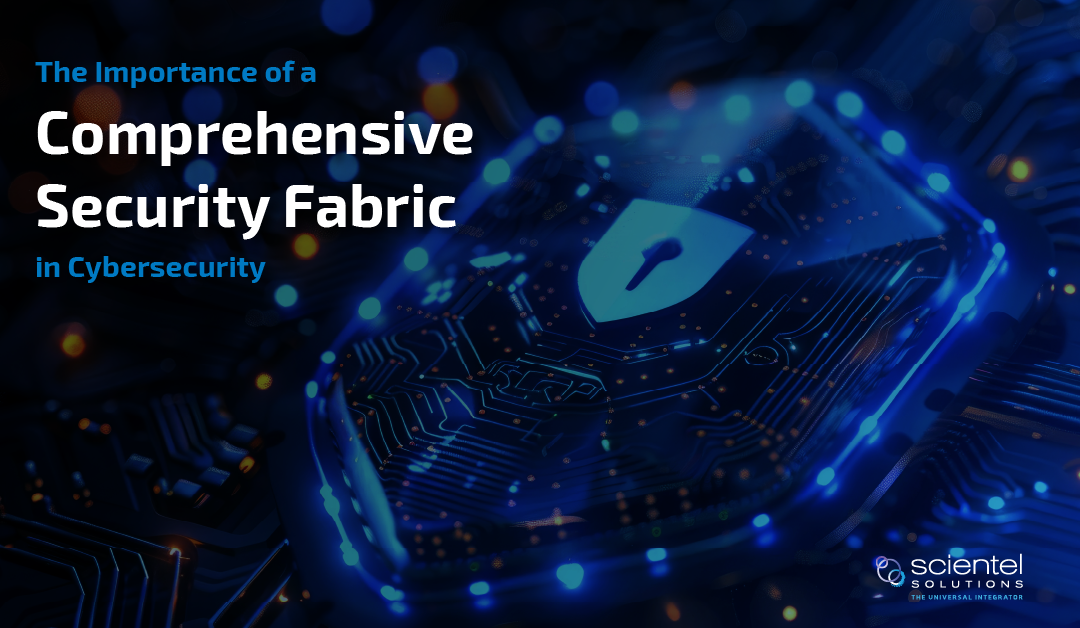by Sanket Patil, Network Engineer
As the digital landscape evolves, organizations face increasing pressure to safeguard their assets while managing their complex IT environment. Cyber threats have become more sophisticated, and the traditional isolated security measures are no longer sufficient. In response, many organizations are turning to comprehensive security fabric frameworks – integrated systems that unify and strengthen cybersecurity measures across an entire digital infrastructure. These frameworks provide enhanced threat detection, centralized management, faster incident response, improved visibility, and scalable protection, making them a critical component of modern cybersecurity strategies. Below are five benefits to having a comprehensive security fabric and its crucial role in protecting modern organizations from ever-evolving threats.
Enhanced Threat Detection
A comprehensive security fabric enhances an organization’s ability to detect emerging and sophisticated threats by enabling real-time data sharing among integrated security tools. Unlike isolated systems, where security tools operate independently, a security fabric allows seamless communication between various components such as firewalls, intrusion detection systems, endpoint protection, and threat intelligence platforms.
This interconnected approach provides a holistic view of the attack surface, allowing anomalies to be analyzed within a broader context. For instance, an endpoint protection system detecting malware can trigger an automatic alert to a network firewall, blocking outbound communication from the infected device. External threat intelligence feeds can be integrated to proactively recognize zero-day vulnerabilities or advanced persistent threats (APTs), significantly reducing blind spots. This continuous flow of information allows organizations to detect and respond to complex, coordinated attacks quickly and accurately, minimizing the risk of threats going unnoticed.
Streamlined Management
Managing multiple security protocols can be complex and prone to errors, especially when each tool operates independently. A security fabric simplifies this process by offering centralized control over an organization’s entire security infrastructure. Instead of juggling multiple dashboards, IT teams can configure, monitor, and update all security components from a single platform.
This centralized management reduces the likelihood of misconfigurations and ensures consistent enforcement of security policies. For instance, administrators can deploy patches, adjust access policies, and review incident logs across all endpoints through one unified interface. Centralized control fosters better collaboration among team members, providing them with access to consistent and up-to-date security information, ultimately strengthening the organization’s security posture.
Faster Incident Response
A quick and effective threat response is crucial in minimizing potential damage. A comprehensive security fabric enhances response times through automated workflows and tool coordination. By integrating and automating detection, analysis, and remediation processes, security systems can react to threats with minimal human intervention.
For example, if a malicious file is detected on an endpoint, the security fabric can automatically alert the firewall to block communication from that device, notify the security team, and initiate a predefined incident response plan. This automation significantly reduces response times, containing threats before they escalate. Additionally, automated workflows alleviate the burden of security teams by handling repetitive tasks, allowing them to focus on complex or high-risk incidents. Predefined response protocols enhance consistency and reduce the risk of errors, enabling organizations to maintain a proactive and resilient security posture.
Improved Visibility
Visibility is critical for maintaining a strong security posture, and a comprehensive security fabric offers a unified view of the entire IT environment. By consolidating data from various sources – such as endpoints, networks, cloud services, and applications – into a single dashboard, security teams are able to easily monitor activities, identify vulnerabilities, and detect potential threats.
This holistic perspective eliminates silos, allowing teams to detect anomalies like unauthorized access attempts or unusual data transfers. Additionally, administrators can pinpoint outdated software or misconfigurations that may leave the organization vulnerable. Continuous security posture assessments become more manageable, enabling teams to proactively address gaps and ensure compliance with industry standards.
Scalability & Flexibility
As organizations grow and their IT environments evolve, their security needs become more complex. A comprehensive security fabric is designed to adapt to these changes, providing scalable and flexible protection that aligns with modern IT ecosystems, including cloud services, Internet of Things (IoT) devices, and remote work setups.
For example, in a cloud environment, a security fabric can dynamically monitor traffic and enforce policies across multiple cloud providers, ensuring consistent protection. Similarly, in IoT deployments, it secures communication between devices, even as new endpoints are added. In remote work scenarios, a security fabric supports zero-trust principles by encrypting data and continuously authenticating users and devices, ensuring secure access to corporate resources. This adaptability reduces the complexity and risk of managing disparate systems while maintaining robust security coverage. By seamlessly integrating with diverse technologies and adjusting to new configurations, a security fabric ensures that organizations remain resilient against threats while embracing innovation and growth.
By integrating diverse security tools into a unified framework, organizations can enhance their threat detection capabilities, streamline operations, and respond to incidents with unparalleled speed and precision. As businesses continue to navigate the complexities of the digital age, adopting a comprehensive security fabric provides the robust, dynamic, and forward-thinking defense necessary to safeguard their assets and ensure long-term resilience.

